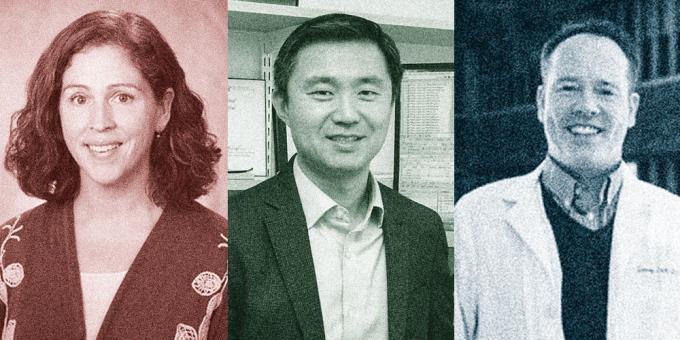

Katherine Bar
Assistant Professor of Medicine, University of Pennsylvania
Jonathan Li, MD
Assistant Professor of Medicine, Division of Infectious Diseases, Brigham and Women’s Hospital
Davey Smith, MD, MAS
Professor and Head, Division of Infectious Diseases & Global Public Health, University of California San Diego School of Medicine
Three researchers talk with PA editor Jeff Berry about ongoing HIV cure research within the ACTG, treatment interruptions, and when we might see a cure
Positively Aware sat down with three researchers who are part of studies within the AIDS Clinical Trials Group laying the foundation for strategies toward an HIV cure: Katherine Bar, MD, Assistant Professor of Medicine, University of Pennsylvania’s Penn Center for AIDS Research; Jonathan Li, MD, Assistant Professor of Medicine, Division of Infectious Diseases, Brigham and Women’s Hospital; and Davey Smith, MD, MAS, Professor and Head, Division of Infectious Diseases & Global Public Health, UC San Diego School of Medicine.
What challenges do you face as cure researchers that researchers who are studying PrEP or vaccines don’t face?
Davey Smith: People say, “Why are you researching that, isn’t it already done?”
Jonathan Li: People don’t realize that there are millions of people out there who don’t have access to affordable, accessible antiretroviral therapy and that the epidemic is raging out of control in many parts of the world. Finding a cure, or HIV remission, or whatever you want to call it, it’s going to decrease transmission, decrease cost, for people who are taking ARTs for decades. If we start ART today, they could be on ART for eight decades of their life, and it’s hard doing that. Any way you can try to find a therapy where they don’t have to take drugs every single day, and avoid some of the adverse effects of ART, to avoid even the stigma of taking HIV drugs every day…
Smith: Or having HIV. My patients say, “Why don’t you cure this so I don’t have to have the stigma of having HIV anymore?”
Did you find in the VRCO1 study that even though you told people this isn’t going to cure you, you’re not going to necessarily see any benefit, that people still thought there would be a benefit, or were hoping there would be?
Katherine Bar: I feel like the individuals that we had as participants were remarkably altruistic in their reasons for participating; we recognized that there wasn’t going to be any benefit to them. My experience with all trial participants, but especially cure, is they are very dedicated to the cause. They want to contribute, they want to help others beside just themselves, [and] they recognize that it’s not going to cure their disease. I don’t think people were looking for a magic bullet cure with the trial, but they were both excited to participate, and excited to have an opportunity, if even for just a few weeks, to stop taking their daily pills.
Li: In addition we had some feedback from some of the clinicians, who were very supportive, saying that once these participants understand that the virus does rebound for them, at a certain point relatively quickly, that could actually help with long-term adherence for these individuals as well, now that their curiosity has been sated. “The virus is going to come back pretty quickly, so I better take my medicines and be good about that.”
Katy, to put it into context for CROI and our discussion, can you talk about your study?
Bar: Sure. We did a study that was basically assessing the effects of a treatment interruption of ART that was looking at the potential of broadly neutralizing antibodies (bNAbs) to suppress viremia. The first trial was A5340 and we asked whether the bNAb could maintain viral suppression in people who stopped their small molecule ART, and that trial showed a modest delay in viral rebound.
We went back for a secondary analysis and asked whether stopping your HIV medicines and having virus come back for a very short period of time would change the latent reservoir of those participants. It helps us understand how the reservoir forms, how it changes, etc. Have we changed that barrier to a cure, or should we in the future develop a better strategy that we could offer to the participants in our trial? But we also want to make sure that for our participants that it’s safe from a clinical context.
So we took samples from nine participants of this trial before the trial started, and 6–9 months after the trial ended, and when their treatment was interrupted, we followed them each week to see when their virus came back. When it came back we checked one more time to make sure that we didn’t have any lab errors, and when we had two weeks of viremia we restarted their ART, and then we watched their virus load go back to undetectable, and after 6–9 months of viral suppression we took another sample.
We compared those two samples, both to see if the size of the reservoir had changed, and to see if the composition—the various populations that we could sample—changed.
What we found was that the size of the viral reservoir did not change with the measures that we took, and when we looked at the virus populations, in the best ways we have currently to look at virus sequences, and ask if they’ve changed, we didn’t see any change in those virus populations over time.
So we think this is a level of reassurance that these short treatment interruptions are indeed safe, and then for understanding the viral reservoir, I think there’s a couple of important takeaway points. First of all we saw a lot of these expanded clonal populations, and they didn’t change in the samples that we took before and after the treatment interruptions. But looking at our different methods of sampling, we got some different virus populations that indicate that it’s very challenging to look beforehand in a preserved sample and predict what viruses are going to come up from latency and rebound to viral replication in a treatment interruption.
Li: At CROI we did look at another ACTG study, A5308, which is antiretroviral therapy for HIV controllers, and Davey and I are also co-chairs for A5345, a prospective study looking for assays and biomarkers to predict when virus will return after they stop therapy.
One of the main hurdles for finding a strategy for HIV remission is that when patients stop therapy we have very little way of predicting when the virus will come back and rebound. We’ve seen there are patients who will rebound relatively quickly, and there are some of these patients known as post-treatment controllers who can maintain full viral suppression and remission for long periods of time.
Is that around 10% of people?
Li: It depends actually on when ART was started. In patients who were started on ART early, I think the chances of having HIV remission is probably 10% or higher. In those who were treated during chronic infection the chances would be lower, and that’s without any interventions, which is part of a poster we presented called the CHAMP study. Understanding when virus will come back, where it’s coming from—what cell types, what tissue types—all of that is vital information as we’re searching for strategies to try to prevent HIV rebound and find strategies for HIV remission.
So that’s in the absence of any other interventions, if you just stop treatment?
Li: That’s right, the study has two different arms—cohorts—patients who were treated with chronic infection, or those treated in early infection. All of these individuals are getting a large volume blood draw leukapheresis [a laboratory procedure in which white blood cells are separated from a sample of blood], so that we see the viral repository, and then afterwards they’re stopping therapy and we’re monitoring them gradually over time to see when the virus will rebound. We’re going to be studying a whole host of assays and biomarkers, and this will be a valuable repository for researchers all over the world, to look at their assays, and validate, and accelerate the validation of some of these assays, to see which can best predict—or maybe which combination of biomarkers and assays can best predict—viral rebound.
So how do you define early infection?
Smith: About a couple of months.
That’s still early.
Smith: We don’t want them too early, actually. We want them to have an immune system response already, so that when the therapy is stopped their immune system is ready to go. Cure [research] right now—there are a lot of things that we just don’t know. We don’t know where the virus is coming from, we don’t know what markers predict viral rebound when it comes back, and who controls and
who doesn’t.
So this A5345 study is based on trying to find some of those very fundamental things out, to spur these cure efforts along the way. That’s the reason this study is very important, for us to figure out these biomarkers, and we’re doing it very carefully, and intensively monitoring people. Previous interruption studies let people be without therapies for a long time, and there were not very many close measurements, we didn’t have a very good idea exactly when rebound happened, and how high did they go, [and] what were the factors associated with it. But as we do cure studies, we’re going to have to stop therapy, that’s how you’re going to know if somebody is cured. This biorepository is already sort of proven to be this valuable resource where people who are interested in these questions are coming to us and, well characterized, will help to spur the field forward.
What would you say to someone who is considering participating in some of these upcoming cure studies?
Bar: Talk to your own doctor about what the benefits of the trial are, what the procedures of the trial are. You want someone who is motivated by altruistic reasons, but it has to work within your own life and be something that you can reasonably do.
Li: They have to be well informed, they have to know everything about the trial.
Bar: Right, and you have to ask questions, and make sure you get answers that are satisfactory.
Do you think that this is going to be like PrEP, and it’s going to take some providers a while to even get on board with some of the studies?
Li: Yes.
Bar: We have some providers, some situations at Penn, although I would think this is a more universal issue, where you have a participant who is very interested but their provider is concerned. They don’t want them to stop therapy, they have been working so hard to get this person to a place where they are undetectable, doing very well—why would we want to mess with that? So I think there needs to be education for both the participant and the provider about safety, about what we could potentially learn, what the benefits of the trial are, so that everybody is on board.
Smith: We also have to inform the partners, people who are perhaps in a serodiscordant relationship—or it could be concordant if we’re talking about superinfection—that there might be some risk because all of a sudden they’re not undetectable anymore for a certain period of time. We did require barrier methods [such as condoms in our study] and we talked about PrEP as an option.
If you could predict when a cure might be discovered, do you see it within the next three, five, ten years? Or is it unknown?
Bar: It’s unknown.
Li: Science progress is not linear; it comes in fits and starts. Breakthroughs can happen at any time. Science occurs in leaps rather than steady walks.
Smith: I will be crazy and say that in the next 10 years there will be people who will [achieve] let’s call it [a] functional [cure], or will be able to go off therapy. I don’t think it will be universal, not anybody and everybody, but there will be some people who we’ll learn a lot from, and we might be able to recapitulate the Timothy Brown experience.
But to be clear, you don’t foresee an actual cure in the next 5–10 years?
Smith: I don’t see a cure for everyone in the next 5–10 years. I think there will be some people who will have better control, if not a functional cure, within 10 years.
Li: A phase 3 clinical trial will take 3–4 years, and there’s nothing even close to a phase 3 clinical trial yet. So 10 years? Maybe.
Smith: I’m going to be audacious and say that in 10 years, there’s a chance that there are going to be a couple of bright stars out there in the sky that say, ‘This is where we need to go. This is how we sail the ship.’
There are some studies coming up, so…
Smith: Yeah, and there are going to be a lot of failures. So one of the things that I do worry about with cure research is that we’re going to have a lot of studies, and they’re not going to work, and they’re going to tell us a whole bunch of stuff that is going to point us in the right direction. I don’t want to tap out the enthusiasm for this by those failures. So as researchers we have to be very cognizant of the fact that there could be some study fatigue for the community. But be realistic when it’s good, and realistic when it’s not going to work. Also go out there and talk about it, and be activists for our own research, and for the ideas and the science, and hopefully our enthusiasm shows, and we do good science that spurs the development.
Portions of this interview have been condensed for space and clarity.
Special thanks to Patrick Bayhylle for his help in coordinating this interview.


